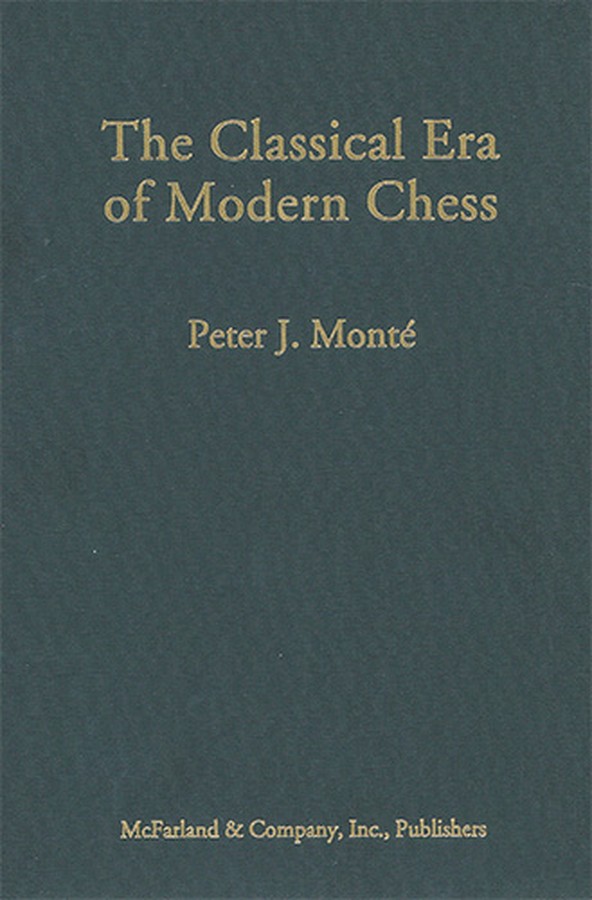| Nivå | A-D |
| Utgivelsesdato | August 2014 |
| Forfatter | |
| Pris | 1000 NOK |
The Classical Era of Modern Chess
Eventyrlig nok kommer plutselig et både nytt, stort og grundig verk om den spennende historien til det nyreformerte sjakkspillet gjennom de første drøyt 150 årene fra slutten av 1400-tallet.
Forlagets egen omtale
A hundred and one years after H.J.R. Murray's A History of Chess comes McFarland's premier offering of chess history, a magisterial work of decades of labor (and two-and-a-half years in editing).
Introduced by Arabs to their new territories in the Mediterranean during the 8th and 9th centuries, the game of chess soon spread throughout Europe, slowly evolving from the less dynamic shatranj version into modern chess.
This study examines the classical era of what became modern chess from the late 15th century into the 1640s.
After tracing the birth of modern chess in Europe, it offers a critical appreciation of all chess literature - including works by von der Lasa, van der Linde, Murray, Chicco, Eales, Petzold, Sanvito, Garzón and many others.
The book also chronicles all the openings and all game moves and all the problems of the era and the development of the laws and rules like the "en passant" capture (much debate!) and castling.
With a glossary and 155 illustrations, this is the definitive overview of a transformative era in the history of chess.
Here, for the first time, ALL books and manuscripts on chess from the early 15th until the first half of the 17th century have been meticulously described and thoroughly researched. The views and opinions of All important chess historians, from the early 19th century until today, have been carefully evaluated.
Peter J. Monte studied ancient history at Leiden University, which granted him a doctorate in 1977. He has written articles on the history of chess and lives in the Netherlands.
Innhold
xiv Acknowledgments
xv Preface
xix Abbreviations
xxi Glossary
Part I - The History of Early Modern Chess
001 Introduction
003 The diffusion of shatranj
014 Medieval chess
019 The birth of modern chess
025 Chapter 1. The First Sources
025 A. Scachs d’amor
031 B. Le Jeu des Esches de la Dame, Moralise
033 Chapter 2. Lucena
036 Rules
037 Openings
039 The Problem Section
065 The Background of Lucena’s Life
067 Dating Lucena’s Book
069 Chapter 3. The Lucena Manuscript
070 Rules
071 Openings
073 Conclusion
074 Chapter 4. The Gottingen Manuscript
076 Date and Origin
079 Rules
079 Openings
082 Comparing Three Sources
083 Conclusion
085 Chapter 5. Damiano
087 Rules
088 Openings
089 Subtleties and Problems
100 Reprints
105 Gruget and Rowbothum
108 White’s Damiano
116 Conclusion
117 Chapter 6. The German Manuscript
118 Rules
118 Openings
120 Subtleties and Problems
122 Conclusion
124 Chapter 7. Ruy Lopez
127 Visiting Rome
129 Rules
133 Openings
136 Italians on Iberian Soil
145 Conclusion
146 The
147 Chapter 8. The Urbinate Manuscript
148 Rules
150 Openings
152 A Spanish and an Italian Author
154 Conclusion
156 Chapter 9. The "Elegance" Manuscripts
156 A. The Elegantia
159 B. The Regole
160 C. The Riccardiana
163 D. Comparing the Documents
163 Rules
166 Openings
170 The Elegantia and the Regole
171 The Italian Manuscripts and the Riccardiana
172 Conclusion
175 Chapter 10. Printed Works of the
175 A. Tarsia
178 B. French
180 C. Selenus
188 Chapter 11. Annibale Romei
190 Rules
191 Openings
192 Subtleties
193 Conclusion
194 Chapter 12. Polerio’s Boncompagno Manuscript No. 1
197 Rules
199 Openings
202 Comparing Other Manuscripts
203 Ascriptions
215 Spanish and Neapolitan Features
217 The Problems
219 Conclusion
222 Chapter 13. Polerio’s Leon Manuscript
222 Rules
223 Openings
226 Contemporaries
227 Conclusion
228 Chapter 14. Polerio’s Boncompagno Manuscript No. 2
230 Dedication
231 Rules
232 Openings
238 Subtleties and Problems
242 Conclusion
244 Chapter 15. Rotilio Gracco
246 Dedication
246 Poetry
247 Rules
248 Openings
248 Conclusion
250 Chapter 16. Polerio’s Ordini Manuscript
251 Dedication
253 Rules
254 Openings
255 The Problem Section
257 Conclusion
260 Chapter 17. Anonymous Works of the
260 A. The Doazan Manuscript
260 Transcriptions
261 Contents
264 Rules
265 Openings
268 The Problem Section
269 Contemporaries
271 Conclusion
274 B. The Boncompagno Manuscript No. 3
275 Rules
275 Openings
277 An Ending
277 Conclusion
278 Chapter 18. Horatio Gianutio
280 Rules
283 Openings
284 The Problem Section
286 Conclusion
288 Chapter 19. Alessandro Salvio
288 His Life
289 The "Trattato" (1604)
291 La Scaccaide (1612)
292 "Il Puttino," "Apologia" and "Seconda Impressione" (1634)
293 Rules
294 Openings
295 Problems and Endings
300 Conclusion
301 Chapter 20. Pietro Carrera
301 His Life
302 His Chess Work
307 Rules
307 Openings
308 Problems and Endings
314 Vespaio’s "Risposta"
316 Conclusion
318 Chapter 21. Gioacchino Greco
318 His Life
321 The Manuscripts
341 Greco’s Sources
344 Presenting Greco’s Writings
347 Rules
348 Openings
350 Problems and Endings
354 Conclusion
355 Chapter 22. The Pawn’s Leap
358 Passar Battaglia
361 Taking En Passant
369 Conclusion
371 Chapter 23. From the King’s Leap to Castling
371 The King’s Leap
387 Castling
410 Conclusion
416 Epilogue
416 Evaluation
417 Miscellanies
428 Aftermath of the Classical Era
439 Part II - Openings and Games of the Classical Era of Modern Chess
531 Part III - Appendices, Bibliography, Index
531 Appendix A. Problem Sections
531 i. Lucena’s problem section
540 ii. Concordance of Problem Sections
546 Appendix B. Concordance of the Lucena-Complex
549 Appendix C. Concordance of the
552 Appendix D. Concordance of the
552 i. Openings
561 ii. Ascriptions
567 Bibliography
577 Index
| Innbundet? | Ja |
| Type | Bok |
| Språk | Engelsk |
| Antall sider | 616 |

